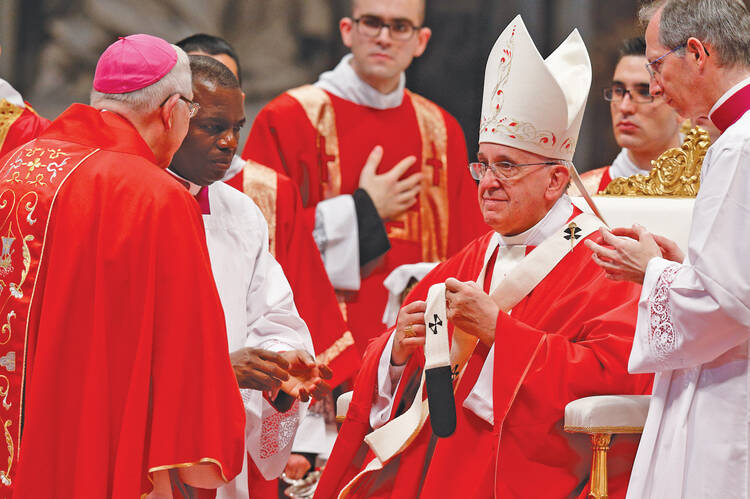Pope Francis has decided that the public ceremony of investiture of metropolitan archbishops with the pallium will henceforth take place in the prelates’ home dioceses, not in the Vatican as has been the case under recent pontiffs.
He believes that in this way the ceremony “will greatly favor the participation of the local church in an important moment of its life and history.” Msgr. Guido Marini, the master of ceremonies of papal liturgies, gave the news in a letter on Jan. 12 to nuncios in countries where there are metropolitan archbishops who were expected to receive the pallium from the pope at the Vatican on June 29, the feast of Sts. Peter and Paul.
According to Monsignor Marini, Pope Francis believes that this new custom can serve to advance “that journey of synodality in the Catholic Church which, from the beginning of his pontificate, he has constantly emphasized as particularly urgent and precious at this time in the history of the church.”
The pallium is a liturgical vestment that symbolizes “the bonds of hierarchical communion between the See of Peter and the Successor of the Apostle and those who are chosen to carry out the episcopal ministry as Metropolitan Archbishop of an Ecclesiastical Province,” Monsignor Marini wrote. It is also a symbol of the metropolitan archbishop’s jurisdiction in his own diocese and in the other dioceses of his ecclesiastical province.
In keeping with the new policy, the new archbishop of Chicago, Blase Cupich, who is the only metropolitan archbishop appointed by Pope Francis in the United States, will concelebrate Mass with the pope in the Vatican on June 29, together with some 40 other metropolitan archbishops from all continents. At the end of Mass, he will receive the pallium from the hands of the pontiff “in a private manner.” Some time afterward, the papal nuncio to the United States, Archbishop Carlo Maria ViganÒ, will invest him with the pallium at a public ceremony in the Archdiocese of Chicago, in the presence of the suffragan bishops of that ecclesiastical province.
The emeritus archbishop of San Francisco, John R. Quinn, has written insightfully on synodality in his book, Ever Ancient, Ever New: Structures of Communion in the Church (Paulist Press, 2013). Commenting on the pope’s gesture, he said, “The decision of Pope Francis that the pallium should be conferred on metropolitan archbishops in their own diocese brings to mind St. Cyprian who, in the third century, said, ‘The bishop is in the Church and the Church is in the bishop.’
“The new papal arrangement serves to emphasize that the giving of the pallium is an ecclesial event, an event of the whole diocese, and not merely a juridical or ceremonial event. ‘The bishop is in the Church.’”
He recalled that the pallium “is the most ancient symbol of the bishop’s office going back as far as the fourth century. It predates the miter and the crosier as episcopal symbols.”
Archbishop Quinn said the pope has introduced this new policy “to underline synodality in the church,” and he recalled that on June, 29, 2013, Pope Francis stated clearly that “synodality is the path of the Catholic Church.” In this light, he said, the pontiff’s decision “becomes a reminder to the Archbishop, to his own diocese and to the bishops and dioceses of his Metropolitan Province that they are being called to open new paths to a true synodality of participation and communion in their churches.”








